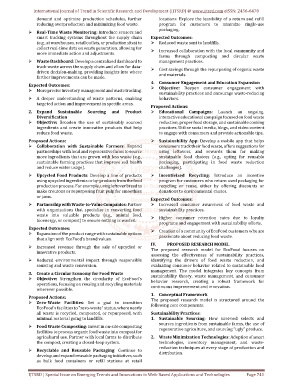Page 751 - Emerging Trends and Innovations in Web-Based Applications and Technologies
P. 751
International Journal of Trend in Scientific Research and Development (IJTSRD) @ www.ijtsrd.com eISSN: 2456-6470
demand and optimize production schedules, further locations. Explore the feasibility of a return and refill
reducing overproduction and minimizing food waste. program for customers to minimize single-use
packaging.
Real-Time Waste Monitoring: Introduce sensors and
smart tracking systems throughout the supply chain Expected Outcomes:
(e.g., at warehouses, retail outlets, or production sites) to Reduced waste sent to landfills.
collect real-time data on waste generation, allowing for
Increased collaboration with the local community and
more immediate action and adjustments.
farms through composting and circular waste
Waste Dashboard: Develop a centralized dashboard to management practices.
track waste across the supply chain and allow for data-
driven decision-making, providing insights into where Cost savings through the repurposing of organic waste
further improvements can be made. and materials.
Expected Outcomes: 4. Consumer Engagement and Education Expansion
More precise inventory management and waste tracking. Objective: Deepen consumer engagement with
sustainability practices and encourage waste-reducing
A deeper understanding of waste patterns, enabling behaviors.
targeted action and improvement in specific areas.
Proposed Actions:
2. Expand Sustainable Sourcing and Product Educational Campaigns: Launch an ongoing,
Diversification interactive educational campaign focused on food waste
Objective: Broaden the use of sustainably sourced reduction, proper food storage, and sustainable cooking
ingredients and create innovative products that help practices. Utilize social media, blogs, and video content
reduce food waste. to engage with consumers and provide actionable tips.
Proposed Actions: Sustainability App: Develop a mobile app that helps
Collaboration with Sustainable Farmers: Expand consumers track their food waste, offers suggestions for
partnerships with local and regenerative farms to source using leftovers, and rewards them for making
more ingredients that are grown with less waste (e.g., sustainable food choices (e.g., opting for reusable
sustainable farming practices that improve soil health packaging, participating in food waste reduction
and reduce water usage). challenges).
Upcycled Food Products: Develop a line of products Incentivized Recycling: Introduce an incentive
using upcycled ingredients or by-products from the food program for customers who return used packaging for
production process. For example, using leftover bread to recycling or reuse, either by offering discounts or
make croutons or repurposing fruit pulp for smoothies donations to environmental causes.
or jams.
Expected Outcomes:
Partnership with Waste-to-Value Companies: Partner Increased consumer awareness of food waste and
with organizations that specialize in converting food sustainability practices.
waste into valuable products (e.g., animal feed,
Higher consumer retention rates due to loyalty
bioenergy, or compost) to ensure nothing is wasted.
programs and engagement with sustainability efforts.
Expected Outcomes:
Expansion of the product range with sustainable options Creation of a community of EcoFood customers who are
that align with EcoFood’s brand values. passionate about reducing food waste.
IV. PROPOSED RESEARCH MODEL
Increased revenue through the sale of upcycled or The proposed research model for EcoFood focuses on
innovative products.
assessing the effectiveness of sustainability practices,
Reduced environmental impact through responsible identifying the drivers of food waste reduction, and
sourcing and waste conversion. evaluating consumer behavior related to sustainable food
3. Create a Circular Economy for Food Waste management. The model integrates key concepts from
Objective: Strengthen the circularity of EcoFood’s sustainability theory, waste management, and consumer
behavior research, creating a robust framework for
operations, focusing on reusing and recycling materials
continuous improvement and innovation.
wherever possible.
Proposed Actions: 1. Conceptual Framework
Zero-Waste Facilities: Set a goal to transition The proposed research model is structured around the
following core components:
EcoFood’s facilities to "zero-waste" status, where nearly
all waste is recycled, composted, or repurposed, with Sustainability Practices:
minimal material going to landfills. 1. Sustainable Sourcing: How EcoFood selects and
sources ingredients from sustainable farms, the use of
Food Waste Composting: Invest in on-site composting
regenerative agriculture, and sourcing “ugly” produce.
facilities to process organic food waste into compost for
agricultural use. Partner with local farms to distribute 2. Waste Minimization Technologies: Adoption of smart
the compost, creating a closed-loop system. technologies, inventory management, and waste-
reduction techniques at every stage of production and
Recyclable and Reusable Packaging: Continue to
distribution.
develop and expand reusable packaging initiatives, such
as bulk food containers or refill stations at retail
IJTSRD | Special Issue on Emerging Trends and Innovations in Web-Based Applications and Technologies Page 741

